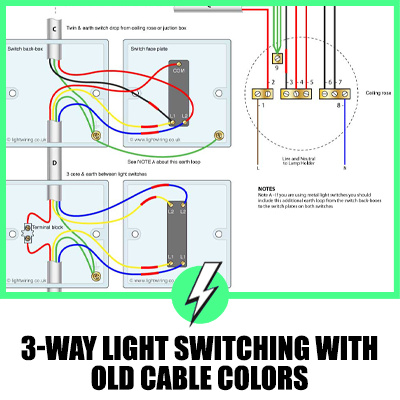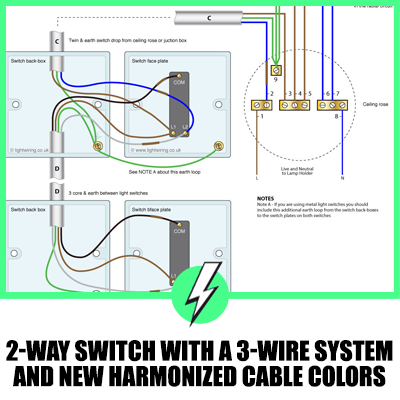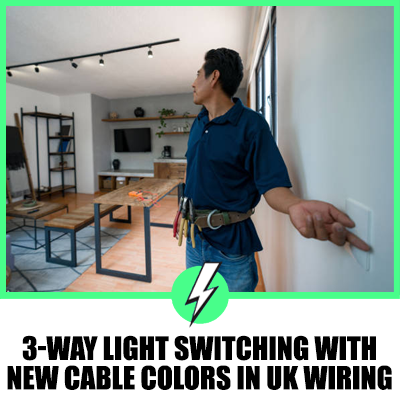3-Way Light Switching with Old Cable Colors in UK Wiring
Curious about how 3-way light switching functioned in the UK with old cable colors?
This method allowed users to control a single light from multiple locations, using a distinct set of cable colors to ensure correct installation and operation.
This article will delve into the intricacies of 3-way light switching with old cable colors, explaining the setup, the components involved, and the operational logic.
We’ll be discussing:
- How did the traditional 3-way light switching system work with the old cable color scheme?
- What were the benefits of using this setup for lighting control in various spaces?
- How has the transition to new cable colors impacted electrical wiring practices?
Join us as we explore the nuances of this classic electrical configuration.
Let’s get started!

Contents
Overview of 3-Way Light Switching with Old Cable Colors
3-way light switching with old cable colors involved the use of multiple switches to control a light or fixture from different locations.
It required specific wiring connections and the use of cables with designated colors to ensure proper installation and operation.
3 way light switching (old cable colours)
Three-way light switching (using old cable colors) involves a lighting circuit known as three-way switching, or sometimes referred to as two-way switching with an intermediate switch.
This configuration enables the control of a single light from any one of the switches involved.
The diagram provided here is based on the older cable color scheme.
For those with wiring in the newer color codes, a different guide is available titled “Three-way switching (new cable colors).”
This setup closely mirrors the two-way switching layout but incorporates an extra intermediate switch within the three-wire control cable that connects the two terminal switches.

fig 1: Three way switching schematic wiring diagram
The circuit consists of a two way switch at each end (top and bottom switches in Fig 2) and an intermediate switch in the middle.
All three switches are connected together by a three core and earth control cable.
Notice that the wire connected to the COM terminals is looped straight through the intermediate switch using a cable connector.
All earth wires should connect to the earth terminal in the switch back-boxes and if you are using metal switches there MUST be a loop from this earth terminal to the one on the switch plate (see note A on Fig 2)
Four way switching and more
This circuit can be extended to four, five way switching by adding additional intermediate switches (wired as shown in fig 2) anywhere along the control cable.
Key Components and Connections
- Three or More Switches: A 3-way light switching setup required the installation of three or more switches. These switches were positioned at different locations within a room or building to enable control of the light or fixture from multiple entry points.
- Old Cable Colors: The old cable colors used in this wiring configuration included:
- Red: Live or line wire
- Black: Switched live wire
- Green/Yellow: Earth wire
- Lighting Point: The lighting point referred to the location of the light or fixture being controlled. It was connected to the switches using the designated cables and appropriate wiring connections.
Switching Operation
The switching operation in a 3-way light switching setup allowed users to control the light or fixture from any of the switches.
Each switch could toggle the light off or on regardless of its previous state.
The live or line wire (red) and the switched live wire (black) were interconnected between the switches to control the flow of electricity.
Advantages of 3-Way Light Switching with Old Cable Colors
- Increased Convenience and Accessibility: 3-way light switching provided users with the convenience of controlling a light or fixture from multiple locations, making it easier to access and operate the lighting.
- Flexible Lighting Control: With multiple switches, users had the freedom to turn the light off or on from different areas or entry points within a room or building, providing flexibility in lighting control.
- Established Wiring Standard: The use of old cable colors, such as red and black, followed a recognized and established wiring standard in the UK, ensuring conformity and ease of installation.
Transition to New Cable Colors
It is important to note that the UK has implemented updated wiring regulations to enhance safety and standardization.
New cable colors have been introduced to align with these regulations.
Therefore, it is crucial to comply with the current standards and guidelines when installing or modifying lighting circuits.
Conclusion
3-way light switching with old cable colors was a widely adopted electrical wiring configuration in the UK.
By understanding its key components, connections, and switching operation, individuals can gain insights into historical electrical wiring practices.
However, it is important to acknowledge the transition to updated wiring regulations and adhere to the current standards for electrical safety and conformity.
The 3-way light switching configuration, with its convenience, flexible lighting control, and adherence to an established wiring standard, played a significant role in lighting installations before the introduction of updated regulations.





